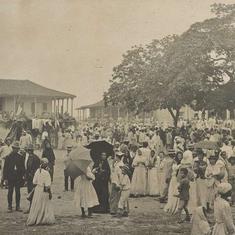For years, the FDA held informal meetings with talc manufacturers to discuss the industry’s asbestos problem. But as public attention grew, agency officials decided that quiet persuasion wasn’t enough.
In August 1971, the agency invited a range of manufacturers, scientists, and officials from other government agencies to come to Washington for a formal conclave. Among the invitees were representatives from Johnson & Johnson and Pfizer, officials from the FDA, the Bureau of Mines, the National Institute for Occupational Safety and Health, and the US Geological Survey, as well as Langer and some of his colleagues from Mount Sinai.
The meeting’s stated goal was to “discuss in detail analytical methods for the determination of minor amounts of ‘asbestos-like’ material in talc with particular reference to cosmetic grade talcs.” The technology to measure asbestos concentrations was evolving rapidly, and the FDA wanted a consensus on what machines to use and how. Regulators also hoped for a decision on how much asbestos was too much.
No firm decisions were reached on any of the crucial issues, but FDA officials came out of the conference deciding that they needed to understand the true extent of the problem. So, in December 1971, the FDA hired Professor Seymour Z Lewin of New York University to analyse consumer talc. In September 1972, Lewin began sharing his results with the FDA: Of the 102 samples of consumer products containing talcum powder, about 40 per cent were contaminated with asbestos, including J&J’s Baby Powder and Shower to Shower products.
Around that time, the National Institute for Occupational Safety and Health released its own test results of nine popular baby powders using electron microscopy. Its study indicated “possible asbestos fibre contamination of commercial baby powders.”
The FDA privately shared Lewin’s results with J&J and other talc manufacturers but didn’t announce them publicly. Nashed, the J&J scientist who had visited the FDA previously, responded by writing to the FDA that removing asbestos entirely from talcum powder was impossible, and he argued that there was no evidence that small amounts of asbestos hurt people.
Whether Nashed actually believed this can’t be known, since he died in 1988. In fact, though, research conducted over the previous twelve years had already demonstrated that even small amounts of asbestos could sicken and kill.
J&J hired Dr Albert M Kligman, a professor of dermatology at the University of Pennsylvania School of Medicine, to find out what would happen both to rabbits and to human beings if they were injected with talc and asbestos.
Kligman was a problematic researcher, to say the least. For many years, he had conducted tests of Johnson’s Baby Powder, as well as Band- Aids, shampoos, and other drugs, on African American prisoners and mentally disabled children. These experiments were often exquisitely painful for his vulnerable subjects.
Kligman wrote a letter dated December 10, 1971, to Hildick-Smith describing his results. First, Kligman injected the rabbits and discovered that the chrysotile sample “produced an intensely granulomatous reaction associated with necrosis and later by cyst formation.” Necrosis means cell or tissue death.
Despite this response, Kligman then proceeded to inject chrysotile samples into the lower backs of ten of the Black prisoners. He noted that the injection sites showed considerable swelling at ten and 20 days, but by 30 days, the obvious irritation had lessened. No one tracked whether the prisoners later developed cancer.
(In 2021, J&J finally expressed remorse for sponsoring such experimentation, explaining: “In no way do they reflect the values or practices we employ today.”)
On and on it went as the FDA’s investigation continued.
A private lab in Chicago got samples of Johnson’s Baby Powder from the same lots as Lewin. The lab declared the samples free of chrysotile, contradicting Lewin. But it did find small amounts of tremolite – 0.5 per cent in one batch and 0.2 per cent to 0.3 per cent in others. When J&J forwarded the Chicago report to the FDA, however, the lab’s line about the tremolite content had been eliminated. (“DO NOT USE THIS REPORT,” someone at J&J wrote by hand on the original report’s cover.) In the cover letter that accompanied the doctored Chicago report, J&J stated that the results clearly showed that the tested samples “contain no chrysotile asbestos.”
In June of 1972, Kretchmer, New York City’s Environmental Protection Administrator, decided that in the year since his first warning, not enough had been done to eliminate asbestos from common baby products. Calling reporters back to his office, he named names.
“Two brands of talcum powder have been named by the city’s Environmental Protection Administration as having heavy asbestos fibre levels that might contribute to lung cancer years after a person inhaled their dust,” read The New York Times story that followed:
“The environment agency’s concern about asbestos in baby powder surfaced almost a year ago, when Jerome Kretchmer, the Environmental Protection Administrator, advised consumers to stop using talcum until suspicions about its asbestos content were cleared up.”
At the time, Mr Kretchmer said two brands tested showed from 5 to 25 per cent asbestos fibres in them but declined to name them until tests on other brands were made.
After repeated inquiries from newsmen, the agency released a letter dated June 8 from James R Marshall, director of public information, to a consumer, naming Landers and Johnson & Johnson as the brands. He said the agency was still awaiting results of tests on other brands, since it suspected that “virtually every talcum powder contains some asbestos.”
Kretchmer’s claim that J&J’s talcum powders contained up to 25 per cent asbestos was wrong – the amounts were far lower. Outraged, Nashed called an FDA official, Dr Robert M Schaffner, and stated that the latest report that J&J had forwarded to the agency from the Chicago lab and other testing sites “prove conclusively the absence of asbestos in our powder.” That was true to an extent – but only because J&J had redacted the tremolite result from the Chicago test. Schaffner got on the phone with the Times, as did Langer, who corrected Kretchmer’s figures.
The next day, the Times published a corrected story titled “Talc Warning Is Labelled False.” Langer was quoted as saying that more recent and detailed analyses had found only trace amounts of asbestos in Johnson & Johnson’s Baby Powder. And “Dr Robert M Schaffner, director of the Office of Product Technology for the FDA, said that out of 40 talcum samples recently tested by the Federal agency, 39 contained only 1 per cent or less of asbestos,” the Times story stated. “Dr Schaffner said that in light of this research, ‘we would not agree with the warning on talc.’ ”
Still, the controversy over the presence of tremolite in talcum powders continued to build, and J&J executives continued their whack-a-mole strategy of discrediting any scientist or report that publicly revealed Baby Powder’s contamination while debating internally whether this plan of action was sustainable. They hired Dr Fred D. Pooley, a professor at the Department of Mineral Exploitation at Cardiff University in Wales, along with two of his colleagues at the university, to analyse the Italian talc the company was still using in the baby powder it sold abroad. The analysis found “very minor amounts” of tremolite, among other impurities.

Excerpted with permission from The Dark Secrets of Johnson & Johnson, Gardiner Harris, Penguin Random House.










